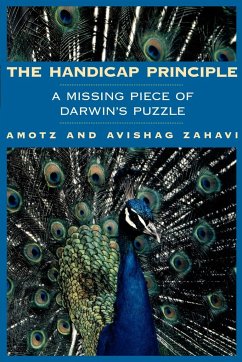The authors convincingly demonstrate that when an animal acts altruistically, it handicaps itself-assumes a risk or endures a sacrifice-not primarily to benefit its kin or social group but to increase its own prestige within the group and thus signal its status as a partner or rival. Finally, the Zahavis' show how many forms of non-verbal communication among humans can also be explained by the Handicap Principle. Indeed, the authors suggest that non-verbal signals-tones of voice, facial expressions, body postures-are quite often more reliable indicators of our intentions than is language. Elegantly written, exhaustively researched, and consistently enlivened by equal measures of insight and example, The Handicap Principle illuminates virtually every kind of animal communication. It not only allows us to hear what animals are saying to each other-and to understand why they are saying it-but also to see the enormously important role non-verbal behaviour plays in human communication.
The handicap principle, first proposed by Zahavi about 17 years ago, has in the past several years become widely accepted as a central unifying theory explaining many previously baffling aspects of animal signalling and communication. It is arguably the most important theoretical advance in animal behaviour in recent years. Basically, the theory states that to be effective, signals must be reliable, and to be reliable, they must be costly to the signaller. This fundamental insight is then developed to explain and illuminate much of animal and human behaviour - why the peacock's tail is so ornate, and why antelope will spend energy stetting or leaping into the air, when they see a predator, instead of running away, but also how humans test each others' commitment by imposing burdens during courtship. Signals are paid attention to only if the signal itself imposes a handicap on the signaller that would make cheating impossible or unprofitable, This book explores the very wide-ranging implications of the handicap principle, for predator-prey relations, sexual selection, parent-offspring relations, coalitions and alliances, and the persistence of altruism, in animals and also in human societies and intercellular signalling within multicellular organisms.
The handicap principle, first proposed by Zahavi about 17 years ago, has in the past several years become widely accepted as a central unifying theory explaining many previously baffling aspects of animal signalling and communication. It is arguably the most important theoretical advance in animal behaviour in recent years. Basically, the theory states that to be effective, signals must be reliable, and to be reliable, they must be costly to the signaller. This fundamental insight is then developed to explain and illuminate much of animal and human behaviour - why the peacock's tail is so ornate, and why antelope will spend energy stetting or leaping into the air, when they see a predator, instead of running away, but also how humans test each others' commitment by imposing burdens during courtship. Signals are paid attention to only if the signal itself imposes a handicap on the signaller that would make cheating impossible or unprofitable, This book explores the very wide-ranging implications of the handicap principle, for predator-prey relations, sexual selection, parent-offspring relations, coalitions and alliances, and the persistence of altruism, in animals and also in human societies and intercellular signalling within multicellular organisms.

